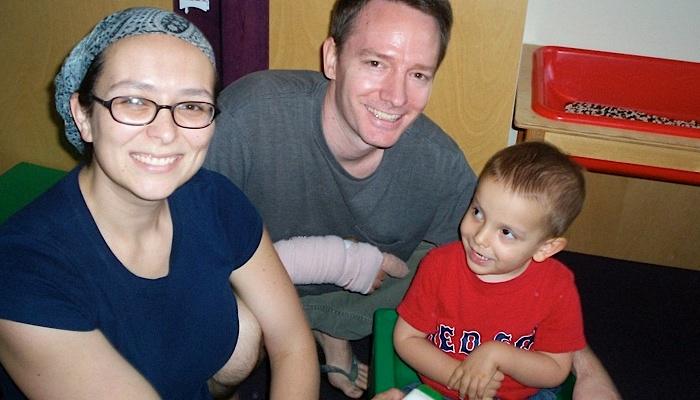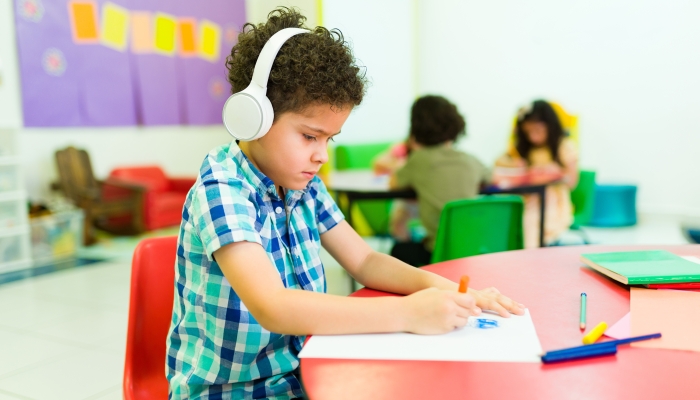IEP’s for Parents of Blind or Visually Impaired Children

This post may contain affiliate links; please see our terms of use for details.
When we were preparing for our son’s first IEP we took classes, attended transition meetings, and read a ton of books.
We received numerous handouts about IEP’s and decided to compile all that information into one place for other parents.
Creating an IEP for your child is a team effort. Depending on your child’s needs, their IEP could be fairly simple or relatively complicated. It’s good to remember that you are going to have to rely on the expertise of everyone on your IEP team to prepare the best plan for your child, but that at the same time you are the most important member of the IEP team.
You know your child and his or her needs best. You know better than anyone how they will react to different environments. With this in mind, it’s a good idea to come to the IEP meeting prepared with typed notes (that you can hand out to other team members if necessary) outlining what you want to see on the IEP.
There are five major areas on the IEP that you should think about when writing your notes. We’ll go through each of these areas so that you can decide what you want your child’s IEP to look like.
What are Parent Concerns & Vision Statements?
What is the Expanded Core Curriculum?
What are Present Levels of Performance, Goals, & Objectives?
What are Parent Concerns & Vision Statements?
There are two places on the IEP where the team wants to hear your voice and no one else’s. This is on the Parent Concerns and the Vision Statement. These are very important parts of the IEP and you should make sure to express yourself here.
Parent Concerns are a list of things you think your child’s teachers should be aware of. This could be anything from your son’s picky eating habits to your daughter’s fear of loud noises, but try to relate these concerns to how your child will learn and grow in school.
This is also a very good place to outline things that you want to see in your child’s program, such as a one-to-one aide at meal time, small class sizes, high teacher-to-student ratio, extra time, or the incorporation of a multi-sensory teaching approach. Think about what the ideal class environment would be for your child and list those things here.
Another way to think about Parent Concerns is in terms of goals. Your child’s teachers will most likely look through your concerns and formulate some goals from them. So, for example, you may say that you are concerned that your child isn’t playing effectively with other children his age. Your child’s teacher may then write a social skills goal relating to interacting with other children and learning age-appropriate play skills.
The Vision Statement is more of a long-term goal for your child. You’re usually asked to think about where you would want to see your child in three to five year’s time.
This can be a very good place to write about the Expanded Core Curriculum. Think about how your child is faring with these expanded core elements and where you would like to see them receiving the most instruction. Would you like to see your child with better daily living skills, better functional language, or maybe having more access to technology? Put these goals in your Vision Statement so the IEP team knows what you want for your child.
| Click here to print What are Parent Concerns & Vision Statements? |
back to top
What is the Expanded Core Curriculum?
If your child is blind or visually impaired, your school district must incorporate these nine elements into your child’s curriculum and these elements must be outlined in your child’s IEP:
- Compensatory or Functional Skills:
Compensatory skills are the skills blind students need to learn in order to access the curriculum. This could include learning spatial awareness, study skills, Braille, large print, or tactile symbols. Learning communication modes falls under this category, such as sign language, a calendar system, or recorded devices. Functional skills are the skills children with multiple disabilities need to learn in order to function (play, learn, take care of themselves) at the highest level possible. - Orientation and Mobility Skills:
This area of the curriculum must be taught by a certified O&M instructor. Blind students need to learn how to move about in their environment safely and independently. They also need to learn about their body and how it moves in space. - Social Skills:
This is one area that is often over looked on an IEP and that parents have to fight for. Children learn social behavior most often by watching other people interact. Blind children don’t have that same opportunity and may not learn social behavior without direct instruction. - Independent Living Skills:
Also referred to as Daily Living Skills, this refers to all the little things you do every day to take care of yourself, such as dressing, brushing your teeth, combing your hair, or toileting. Other skills that fall under this category may be learning to prepare your own meals or manage your money. How this appears on your child’s IEP of course depends on his or her level of ability, but think of Daily Living Skills as the skills your child needs to live as independent a life as possible. - Recreation and Leisure Skills:
Many team games and sports played in Physical Education classes are easily adapted for blind and visually impaired children, but blind kids may need extra instruction in learning how to participate in these games and choosing physical or other recreational activities that appeal to them. - Career Education:
This does not necessarily mean preparing a child to enter the work force, so much as it refers to teaching a child about what work is. Does your child know what sort of behavior would be expected of them in an office or in a factory? Does your child know what a mechanic does, or a cook? If they haven’t had first-hand experience with vocational training, they will be at a great disadvantage when they are searching for employment. - Use of Assistive Technology:
The amazing world of technological gadgets available to blind students is always expanding and if your child is to stay competitive and up-to-date they are going to need constant instruction in the equipment that is most suitable for them. - Sensory Efficiency Skills:
This area involves learning how to use what ever limited vision your child has, or learning to use other senses, such as hearing or smell. Children with low vision need instruction in how and when to use the vision they have, children with low hearing need to learn how to use hearing aides, and all children with sensory impairments need to learn how to use their other senses to fill in the gaps. - Self-Determination:
This is probably more important than you may first think and can also apply to rather young children. Children with disabilities are often taught to be taken care of rather than take care of themselves. Your child will need to learn when it is appropriate to ask for help, how to set long term goals for themselves, and when to tell someone if they are uncomfortable.
| Click here to print What is the Expanded Core Curriculum? |
back to top
What are Accommodations?
Accommodations are changes to the classroom or to your child’s environment that allow him or her easier access to the general curriculum. Accommodations do not change the curriculum; instead they enhance your child’s ability to keep pace with the general classroom curriculum.
Accommodations are part of your child’s IEP and for Visually Impaired students this may include…
- Paraprofessional or aide
- Extra time to complete an assignment
- Time out /rest time
- Schedule adjustments
- Seating
- Placement of materials
- Slant board
- Large print
- Tactile representations or displays including Braille
- Special grips for or sizes of writing utensils
- Special cushion for a chair
- Curtains to shield glare
- Dimmer switches
- Directed lighting
- Non cluttered environment
- Special spoon or cup or dish
- Bus monitor
- High contrast markings or cones on playground
- RR ties around swings
- Bell inside a ball
- Recorded materials
- Brailler
- Special lined paper
- Magnifier
- Grips to help child turn pages
- Signs labels and tactile markers
- Extra book for child to hold and see up close
Your child’s teachers and/or aides may also need to accommodate their teaching styles and this should also be outlined in the IEP. Here are some things to consider…
- Give curriculum to TVI in advance so TVI can adapt the curriculum
- Try to keep a clear path from the door into the room
- Encourage students to keep personal items out of pathways between desks
- Make sure the classroom has adequate lighting
- Assist as needed with allowing space for adapted materials
- Face the class and window when speaking. Student should not be looking into light; the window should be behind the student
- Use dark markers on the whiteboard
- Read aloud what you write on the whiteboard or present in PowerPoint
- Give student his or her own copy of visuals that are displayed on the white board
- When possible give child his or her own copy of any book
- Any book you are reading to the class can be sent home the night before to facilitate pre-teaching at home
- Verbally describe objects and processes whenever possible
- When giving directions, make them as clear and detailed as possible
- Call a roll at the beginning of class
- If your student has low vision point out something highly visible about the other students (for example, color of clothing)
- Refer to students by name
- During class discussions, ask speakers to identify themselves by name
- Inform parents, TVI and, O&M about field trips in advance so they can prepare student and make safety recommendations/arrangements
- Provide written items in enlarged font
- Allow the student priority seating
- Allow tape recording
- Mark drop offs or steps up with high-contrast yellow tape for children with low vision; for children with no vision use some other sensory application (tactile or auditory)
- Leave doors fully opened or closed. A door ajar can be confusing and hazardous, especially to a child with partial sight
- Never leave the child in open space. If you must leave the child alone for a moment, leave him or her in contact with some stationary object
| Click here to print What are Accommodations? |
back to top
What are Modifications?
Modifications are changes to the actual curriculum. In other words, modifications are changes in what your child is taught and are based on your child’s special strengths and abilities.
Modifications may be minimal or very complex depending on the student’s performance and must be clearly outlined in the IEP. For example:
- Your child may be excused from certain parts of the curriculum (For example, your child could be pulled out of PE and may have Sensory Integration activities instead; if your child is deaf blind, they may leave singing and participate in coactive movement instead; or your child may attend only three days of a five day program and be excused from specific learning).
- Your child may be taught or tested at a lower grade level.
- Your child may be included in the same activity, but with individualized expectations and materials.
- In some cases children in out of district or substantially separate placements are taught a curriculum significantly different from those children in their LEA (Local Educational Agency) preschool or integrated program.
| Click here to print What are Modifications? |
back to top
What are Present Levels of Performance, Goals, & Objectives?
On a typical IEP (and keep in mind that the actual look of the document differs from state to state), the heart of the document will be a collection of current levels of performance and goals.
Present Levels of Performance (also called Current Levels of Performance) are exactly what they sound like: This is an explanation, usually by your child’s therapist, of what your child can and can’t do right now. Some school districts will bring in outside experts to evaluate your child, especially if this is your first IEP, but it is best to have your child’s performance evaluated by someone who knows them and has a history of working with them.
Here is an example from Ivan’s IEP:
Ivan has difficulty separating from his parents. He experiences tantrum behavior and a distressed emotional state when separated from his parents. He has a difficult time calming himself.
You then create Goals and Objectives to address this Present Level of Performance. Goals and Objectives get a lot of attention in IEP books and classes, but we’ve found that though they are very important, they aren’t nearly as frightening or complicated as the books make them out to be.
Simply put, goals are measurable challenges that you want your child to meet. The important thing is that the goal be measurable so you can tell if it has been accomplished or not. Here is an example from Ivan’s IEP:
Ivan will participate in a preschool classroom by transitioning in, separating, maintaining his composure, and engaging in activities for a 3 hour period 4 out of 5 days per week.
After the goal, the IEP team develops objectives, or things your child will need to do in order to meet their goal. Again from Ivan’s IEP:
Within 10-15 minutes of arriving at school, Ivan will separate from his parents and begin his school day 4/5 days over a 3 week period.
During lunch time in the classroom, Ivan will tolerate sitting at the table and eating his food for a 10 minute period 4/5 days over 3 weeks.
Though it is important to come to your IEP meeting with a list of goals you’d like to see on your child’s IEP, don’t spend too much time trying to write them in this sort of language at home. That’s best left to the professionals. Write your goals and objectives as a team, but be sure to be prepared to give your own valuable input as well.
| Click here to print What are Present Levels of Performance, Goals, & Objectives? |
back to top
Sample IEPs
We’ve gathered a few sample IEPs from parents of blind and visually impaired children of varying abilities and link to them here for you to download. These are real IEPs for real children (though the children’s names have been removed).
Hopefully these will give you an idea of what an IEP looks like and what other parents are asking for.
If you want to contribute your own IEP, please let us know.
These files are pretty big, so give them some time to download.
Resources & Further Reading
There are many books and websites out there designed to help you navigate through the confusing special education system. Here are our favorites…
Books
- A Parents’ Guide to Special Education for Children with Visual Impairments
- Better IEPs: How to Develop Legally Correct and Educationally Useful Programs
- Writing Measurable IEP Goals and Objectives
- From Emotions to Advocacy: The Special Education Survival Guide
- Special Education Law
Websites
- AFB: The Expanded Core Curriculum
- Disability.gov
- Wrightslaw: Special Education Law and Advocacy
- Hands & Voices: Pop-Up IEP
- IEP Resources for Children with Albinism
- What Schools May Not Know About a Student with a Visual Impairment
- Sample Goals & Objectives for Learners Who are Blind or Visually Impaired
- IEP’s: Updates, Tips, and Strategies from NFB
- IEP Services Checklist for Parents of Blind Children
- Placement: The Natural Outcome of the IEP
- IEP Goals and Objectives Bank
Related Posts

IEPs
5 Sample Self-Advocacy IEP Goals
Understanding the steps towards growing self-advocacy at school is an important part of building independence and self-efficacy for students.

IEPs
8 Sample Behavior IEP Goals
Find out how specific, measurable, and attainable behavior IEP goals help your child learn coping strategies and problem-solving skills, leading to more progress.

IEPs, Special Needs
Can AI Write My Student’s Next IEP?
While there are pros and cons, educators can use AI to help write a child’s IEP, streamlining the process.